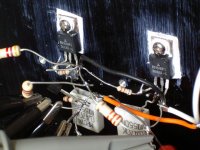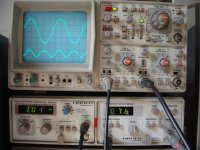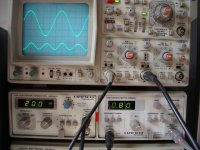Take the MRFE6VP5600HR5, you get it from Mouser and DigiKey in single quantities.
No SiC-switching-transistor will ever reach this performance !
Well the prices are comparable but SiC has ten times higher voltage rating - why would one compare oranges with apples.
hmm interesting thanks !
Will try and buy a couple of RD100HHF1 to try out in the F6 and see what blows up (rf transistors, inductors and capacitors in close prximity - )
First of all, this must be humourus. Absolutely no one in this bisness has the ability to know what will be happening even in the near term. It's a little like the Stock Market:The commercial SIT is dead: long live the V-FET !!!
You have some proof of this? Some examples maybe? If this actually were the case, there are plenty willing to do whatever is necessary to build the best equipment with the best components. Where are all these products? Just calling them 1000W transistors is incorrect when refering to DC characteristics like typical parameters of typical audio devices.This 1000W-Transistor eats SiC-FETs and V-FETs for breakfast in Audio.
...snip...
You have some proof of this? Some examples maybe?
...snip...
RF devices are good because the nonlinear capacitances are much smaller, so their contribution to distortion at 20kHz is much less. For example, here is a test setup with 2x RD16HHF1, Zen Classic, 30V/2A, 1W/8ohm, measured at 1kHz and 20kHz. While at 1kHz the RD16HHF1 measures very similar to the original, the distortion at 20kHz is essentially unchanged - big improvement.
Attachments
http://www.infineon.com/dgdl/Infine...b12ac&fileId=db3a3043372d5cc801376f50964a3e6b
Seems infinon have also integrated a diode
There are some coss ciss crss curves in there
Seems infinon have also integrated a diode
There are some coss ciss crss curves in there
V-FET (SIT) was great, but RF LDMOS is promising to be better in simplistic Class A
This was related to DIYaudio and yes: At the moment the commercially available SIT seems to be dead, except Nelson Pass starts selling his SET-1 without an amplifier around it for less than 100 USD ...
A transistor, which is able to dissipate 1000W DC and source currents of 20A+ is ahead of anything conventional regarding SOA, and there are enough 55V RF linear transistors around, which meet this spec or come at least close.
As tbece mentioned (bravo !!), regarding AC performance, in Class A these must be better than any Audio transistor and 600V+ (SiC, SIT or whatsoever) switching transistor, because Crss and its nonlinear portions are a few degrees of magnitude smaller at voltages around 20V and that's the region where audio is taking place, not at 200V or 500V, where SiC switches get somehow better but not very good.
And: If a big gray crowd is not able to get a certain point for decades or even centuries, a single visionary or a few of them can nevertheless be totally right. The history of science teaches this lesson. There are many examples.
And No: I don't have a proof of an actual circuit for you, but I have an open mind and probably many other members here have also one, instead of running behind a guru or second order marketing blah from Hifi mags, saying that SiC is superior to Silicon for Audio whatsoever ...
or second order marketing blah from Hifi mags, saying that SiC is superior to Silicon for Audio whatsoever ...
Btw.: I promoted the classic V-FET amplifier and the transistors for more than eight years (At times, when they weren't en vogue) on another forum, but only a few people believed me. Some also asked for a proof. My proof is that I listened to all commercially available classic V-FET amps and I drew my own independent conclusions ... I could even pretend that I listened to more different SIT amplifier designs than anybody else on this planet. Unfortunately this doesn't help to convince people, who didn't actually listen to any of these amplifiers.
Probably we need to wait until NP starts to promote LDMOS RF transistors in let's say five years (When perhaps the die attach solder of his SIT-1 transistors starts to get non RoHS compliant or the like), then the crowd of LDMOS believers will certainly grow but the number of people, who are looking into the future will still stay very small.
First of all, this must be humourus. Absolutely no one in this bisness has the ability to know what will be happening even in the near term. It's a little like the Stock Market
This was related to DIYaudio and yes: At the moment the commercially available SIT seems to be dead, except Nelson Pass starts selling his SET-1 without an amplifier around it for less than 100 USD ...
You have some proof of this? Some examples maybe? If this actually were the case, there are plenty willing to do whatever is necessary to build the best equipment with the best components. Where are all these products? Just calling them 1000W transistors is incorrect when refering to DC characteristics like typical parameters of typical audio devices.
A transistor, which is able to dissipate 1000W DC and source currents of 20A+ is ahead of anything conventional regarding SOA, and there are enough 55V RF linear transistors around, which meet this spec or come at least close.
As tbece mentioned (bravo !!), regarding AC performance, in Class A these must be better than any Audio transistor and 600V+ (SiC, SIT or whatsoever) switching transistor, because Crss and its nonlinear portions are a few degrees of magnitude smaller at voltages around 20V and that's the region where audio is taking place, not at 200V or 500V, where SiC switches get somehow better but not very good.
And: If a big gray crowd is not able to get a certain point for decades or even centuries, a single visionary or a few of them can nevertheless be totally right. The history of science teaches this lesson. There are many examples.
And No: I don't have a proof of an actual circuit for you, but I have an open mind and probably many other members here have also one, instead of running behind a guru
 or second order marketing blah from Hifi mags, saying that SiC is superior to Silicon for Audio whatsoever ...
or second order marketing blah from Hifi mags, saying that SiC is superior to Silicon for Audio whatsoever ...Btw.: I promoted the classic V-FET amplifier and the transistors for more than eight years (At times, when they weren't en vogue) on another forum, but only a few people believed me. Some also asked for a proof. My proof is that I listened to all commercially available classic V-FET amps and I drew my own independent conclusions ... I could even pretend that I listened to more different SIT amplifier designs than anybody else on this planet. Unfortunately this doesn't help to convince people, who didn't actually listen to any of these amplifiers.
Probably we need to wait until NP starts to promote LDMOS RF transistors in let's say five years (When perhaps the die attach solder of his SIT-1 transistors starts to get non RoHS compliant or the like), then the crowd of LDMOS believers will certainly grow but the number of people, who are looking into the future will still stay very small.
Last edited:
RF devices are good because the nonlinear capacitances are much smaller, so their contribution to distortion at 20kHz is much less. For example, here is a test setup with 2x RD16HHF1, Zen Classic, 30V/2A, 1W/8ohm, measured at 1kHz and 20kHz. While at 1kHz the RD16HHF1 measures very similar to the original, the distortion at 20kHz is essentially unchanged - big improvement.
This is really great, the Zen design is probably the most pathologic case for Crss induced distortion, because Crss lies there parallel to the feedback resistor.
Using an ordinary VMOS or a Power-J-FET provokes Phase Intermodulation Distortion in the range of a microsecond or so.
Nobody would ever like to listen to digital Audio with a Jitter of 1us at 20kHz.
PIM and Jitter have the same mechanisms behind of them and sound very similar ...
Let me guess, the RD16HHF1-Version sounds more open, less blurry, much wider and deeper in sound stage etc., even when the 1 kHz THD is not (much) better ...
The data sheet seems to show some qualities such as linearity and low C that are quite worth the experimentation excerise. The device seems to have miniscule amounts of gain? And, it seems a little power limited for Class A use. But, I see you are running it at 30V - 2A in your Zen? That's more than the Absolute Max Rating even if you could keep it cool with that Rth j-c?
How does it sound would be the real point of the matter.
How does it sound would be the real point of the matter.
Using an ordinary VMOS or a Power-J-FET
provokes Phase Intermodulation Distortion in the range of a microsecond or
so. Nobody would ever like to listen to digital Audio with a Jitter of 1us at
20kHz. PIM and Jitter have the same mechanisms behind of them and sound
very similar ...
Since there are examples of people who apparently like the sound of the
Zen, this doesn't make for a very strict argument against 1uS jitter.
Btw.: I promoted the classic V-FET amplifier and the transistors for more than eight years (At times, when they weren't en vogue) on another forum, but only a few people believed me. Some also asked for a proof. My proof is that I listened to all commercially available classic V-FET amps and I drew my own independent conclusions ... I could even pretend that I listened to more different SIT amplifier designs than anybody else on this planet. Unfortunately this doesn't help to convince people, who didn't actually listen to any of these amplifiers.
Probably we need to wait until NP starts to promote LDMOS RF transistors in let's say five years (When perhaps the die attach solder of his SIT-1 transistors starts to get non RoHS compliant or the like), then the crowd of LDMOS believers will certainly grow but the number of people, who are looking into the future will still stay very small.
Guys, we do need advances in measurement approaches, that really correlate with sound perception. Otherwise, we cant proove anything to anybody, saying that it sounds good, except for a case, when GURU is saying something. But guru is not a god, he must not say absolute truth, he could have some hidden ideas behind his posts.
RD100HHF1 are not that expensive, around 30$, and I tested them at few designs. Jon Lord said: "Let me guess, the RD16HHF1-Version sounds more open, less blurry, much wider and deeper in sound stage etc., even when the 1 kHz THD is not (much) better ..."
That is also close to my impression. However, when an initial euphoria passes out, one could mention, that there are still differences at bass, depending on what kind of parts used at output stages.
With laterals, one can made Zout as low as 1mOhms, but bass perception can differ from that with bjt power transistors, and many will find the difference is not in favour of laterals. This is another puzzle of AUDIO, I can not explain it by measurements. In this respect, SITs are sitting somethere in between the laterals and bjts, but, there advantage, they provide an exceptional sound "purity" and easy to listen for long period, like NoGNFB designs.
To me, Ge BJTs are the best output transistors for proper bass reproduction, but, their specific properties (terrible thermal run away), that intuitively can help for proper bass, objectively look like a reason of "bad" thermal distortions.
SiC parts, except for applications at some specific schematics that need depletion mode parts, do not promise special benefits. I agree with Jon Lord, that LDMOS are generally superior to SiC parts.
Last edited:
:The commercial SIT is dead: long live the V-FET !!!
How about LDMOS RF FETs like NXP BLF578XR ???
This 1000W-Transistor eats SiC-FETs and V-FETs for breakfast in Audio.
I would love to see someone make a stereo amp with these. I wonder how it would perform.
TranSiC was a Swedish company that supposedly developed an SiC bipolar transistor that had significant advantages over silicon transistors, though they never did so much as publish a data sheet to substantiate their claims. Fairchild acquired them (or their IP - they were small).
Given the difficulties in doing anything SiC-related, I won't hold my breath until I can buy some of their product with real money. People are still trying to figure out how to grow SiC wafers with low defect densities, and how to process the wafers once they have them. The 50 years or so experience with Si doesn't mean anything, as SiC is an entirely different ball game. Semisouth went under in part because they lost their process and couldn't get back to a decent product yield (that would have still been crappy compared to what is currently expected as a routine matter for Si). To add to the difficulty, the wafer sizes are much smaller with SiC (meaning that the "sweet spot" for high yield is proportionately much smaller, and the base material is much, much more expensive (at least 10X) than Si. I can't blame anyone in the SiC business for going slow and keeping their cards very close to their chests...
Given the difficulties in doing anything SiC-related, I won't hold my breath until I can buy some of their product with real money. People are still trying to figure out how to grow SiC wafers with low defect densities, and how to process the wafers once they have them. The 50 years or so experience with Si doesn't mean anything, as SiC is an entirely different ball game. Semisouth went under in part because they lost their process and couldn't get back to a decent product yield (that would have still been crappy compared to what is currently expected as a routine matter for Si). To add to the difficulty, the wafer sizes are much smaller with SiC (meaning that the "sweet spot" for high yield is proportionately much smaller, and the base material is much, much more expensive (at least 10X) than Si. I can't blame anyone in the SiC business for going slow and keeping their cards very close to their chests...
they sent me datasheets back then when I asked, but I never got around to getting samples. I wasnt aware of semisouth losing their process, what exactly to you mean by that? they had to move fabs, or they sold the rights to the process they were using at MIT?
let me know if its still of any interest and i'll send you the datasheet. at least I think they did, i'll check. I have a folder with some files at the very least
yep I have one for BitSiC BT1212AC-P1
let me know if its still of any interest and i'll send you the datasheet. at least I think they did, i'll check. I have a folder with some files at the very least
yep I have one for BitSiC BT1212AC-P1
Last edited:
- Home
- Amplifiers
- Pass Labs
- Semisouth goes Dodo ; what now ?



